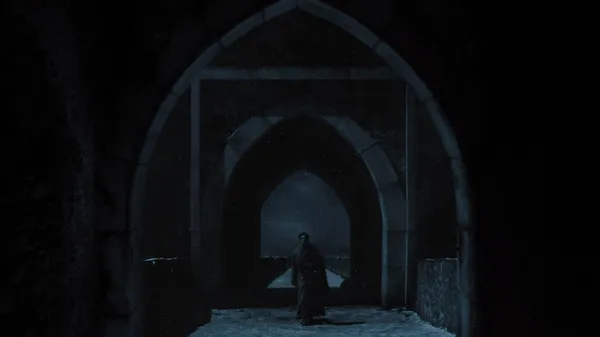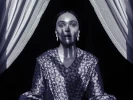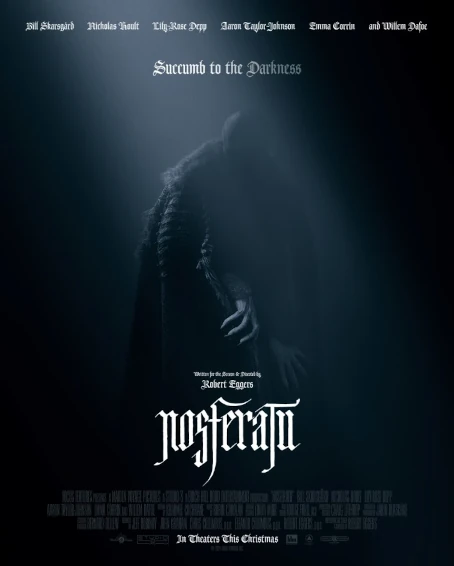Eye For Film >> Movies >> Nosferatu (2024) Film Review
Nosferatu
Reviewed by: Andrew Robertson

Before the word nosferatu appears in a blackletter elongated to the point of imbalance, that first 'n' deliberately rendered here in lower case because it seems intent on the improper, there is darkness. Initially punctuated by other seeming handwriting, versions of production company logos that could have been scratched on negatives but were likely placed by mice. Then another darkness, an evening, of black and white. A recurring element, lunar glow upon the silver screen.
Recurring an inevitable consequence, perhaps, of something that is perhaps not a remake. Treading in the complicated ground of Murnau's initial offering, that work owes debts eventually given legal weight to Bram Stoker's Dracula. Count Orlok is not he, nor the Hutters the Harkers, nor Von Franz Van Helsing nor Wisberg Whitby, but it's close. Closer still here, with explicit credit for ideas reintroduced or reincorporated or repossessed from Dracula into this Nosferatu. At one point scholars of the stories may remark "but that's Dracula!" but that is perhaps itself a ruse.

Remake is perhaps less apt than revisitation, if not outright revision. Reflecting upon it I am caught because I think this undeniably David Eggers' Nosferatu but so too was Bram Stoker's Dracula actually Francis Ford Coppola's, was Gus Van Sant's Psycho. For a movie whose title suggests it is the author's version it is a point of incredible trivia that there is a novelisation of that film, based upon James V Hart and written by Fred Saberhagen.
That kind of obsessive detail is abundant in Nosferatu, a film whose textures and depths carry the hallmarks of Eggers' work. Embroidery fills the screen, itself old-fashioned in its framing in the 5:3 aspect ratio. The original, if one can call it that, was in the even older Academy or 4:3. Watching it now there are moments where it is experimenting with the still nascent vocabulary and grammar of film. I've been with modern audiences who have laughed at the dropped frames and cranked footage of Orlok's funereal coach. That the technique still works for other crazed conveyances that are almost always in the centre of our focus. Tricks like the negative exposure of a white-coloured stand-in that keep the dread wagon black against uncanny woodland are almost literally stark contrast to this version's tracking shots through inns lit by guttering candles.
Shot on film with his frequent collaborator Jarin Blaschke, it seems almost redundant to say this looks like an Eggers film. One day, perhaps, he will shoot a feature set after the invention of the tea bag or the zeppelin, but these are not those days. Until then we will have alleys even Caligari and Poe would rue, mannered Dutch-angles in the holds of Russian ships sailing into German harbours, wood and film-grain. Among the moments of technical wizardry a small crocodile hanging from a ceiling, though as any scholar of unseen universities would tell you, that's more wizardry by technicality.
Abundant rats! Makeup and special effects recalls the tone of other horrors, if not the substance. Among the many reflections and recollections it becomes clear that Count Orlok could conceal any number of cards up his sleeves. As with (Coppola's) Stoker's Dracula there are moments where aesthetic choices seem less a lens on literary devices than gilt upon lilies. There's nothing as brave as a locomotive running across pages or a castle that is itself a throne, but add enough maggots and blisters and one's cup doth not just boil but runneth over. There are also moments where it seems actors are engaging with the material full-throated but are not singing from the same scenery or chewing the same hymn-sheet.
Lily-Rose Depp's Ellen is the point around which various sigils revolve. It is to her that Bill Skarsgard's Orlok is drawn, though beneath prosthetics and a simulacrum of ancient Dacien it might have been anyway so penned. Nicholas Hoult adds another role in the seminal vampiric pentacle to his name, but that hammers home the complicated company he keeps in doing so. Willem Dafoe has been cast as a vampire's shadow before, in one of many deeper nods to the original(s) he is Albin Eberhardt Von Franz, though the occultist is a re-addition to Nosferatu's physicians. Albin is taken from Nosferatu's production designer, himself interested in craft other than stage.
Even writing that out feels doubly expository, as his presence is one of several places where the things taken out to make Nosferatu have been sewn back in to make something that was lean saggy, something that had been cut bloated. To engage with sources and become engorged, to find old new ways of making it all about love and sex and death and disease and where the lines are drawn between those all as effects and causes.
There wasn't 'a' Germany in 1838, but the German Confederation probably counts the fictional Wisborg not by Trieste on the Adriatic but somewhere up on the Nordsee by the Niederlande. When Hutter rides off to sell property at employer's instruction it is past untilted windmills. There's a Visborg up on Gotland but any sense of place in the original is already muddied by what versions have been retained. It is perhaps in that aspect of retelling that this Nosferatu is strongest, but it also where I find it weakest.
In a feat that outmatches Dune: Part Two by half a century, this is an adaptation of an older work that feels more sexist. While credit is given to Henrik Galeen here, his Symphony of Horror was less 'freely adapted' than 'legally resemblant'. With its first German language publication just 14 years before, one of the many changes we owe to Galeen and Murnau is the sense that Mina (Ellen) and Dracula (Orlok) are bound to each other by anything more than Gothic contrivance. It's also telling that their adaptation seeks to give her more agency, and sad that this resurrection replaces composure with culpability.
We have a bride of the vampire, a black bonnet as halo, any quantity of the visceral, loves that transcend the boundaries of death and devotion that crosses yet more barriers and borders. The score by Robin Carolan gives Eggers' Nosferatu something Murnau's never really had, a consistency of chords that silent film can't keep. Even if your great-grandparents' local cinema had the notes there's no guarantee they were in an appropriate order. It's that reshuffling that I think is where Nosferatu's retelling becomes something less than a rediscovery, a reimagining, and as I reflect upon it further I'd be remiss to say other than that I find it regrettable. The Northman was also several retellings but it was a tale of all-consuming vengeance and not vengeance upon the all-consuming. It is an irony that in its appetites Nosferatu may not have consumed enough, a tale of a vampire that is anaemic not solely because of muted palettes but because of what has gone unread.
Reviewed on: 03 Jan 2025

















